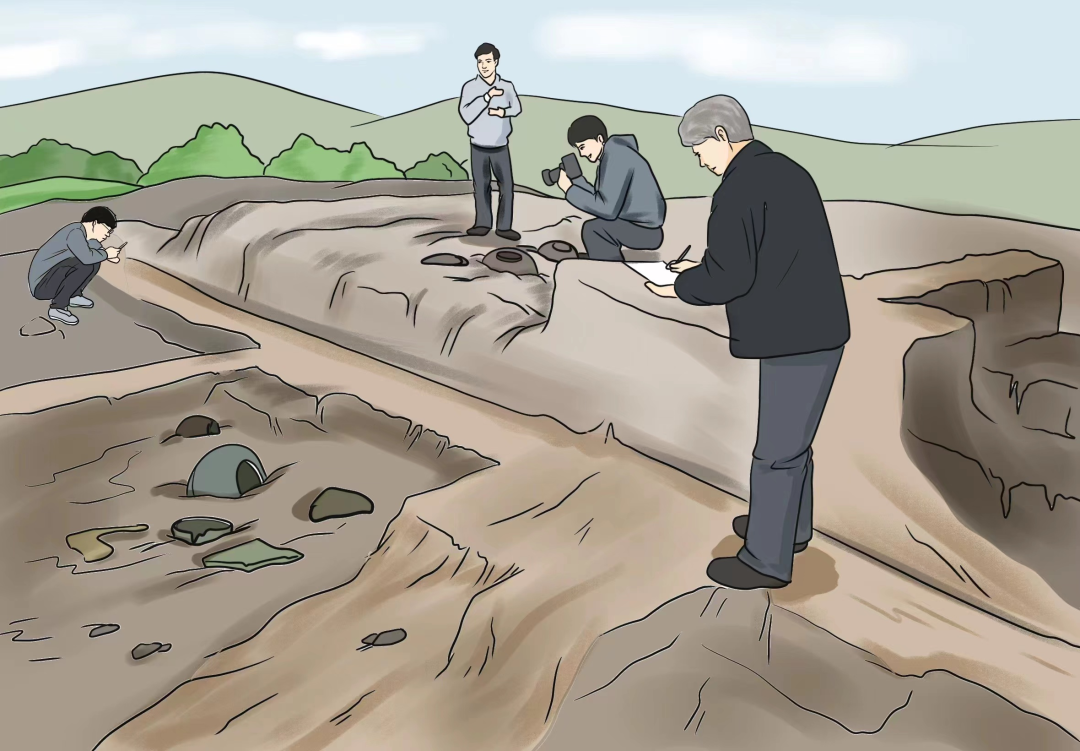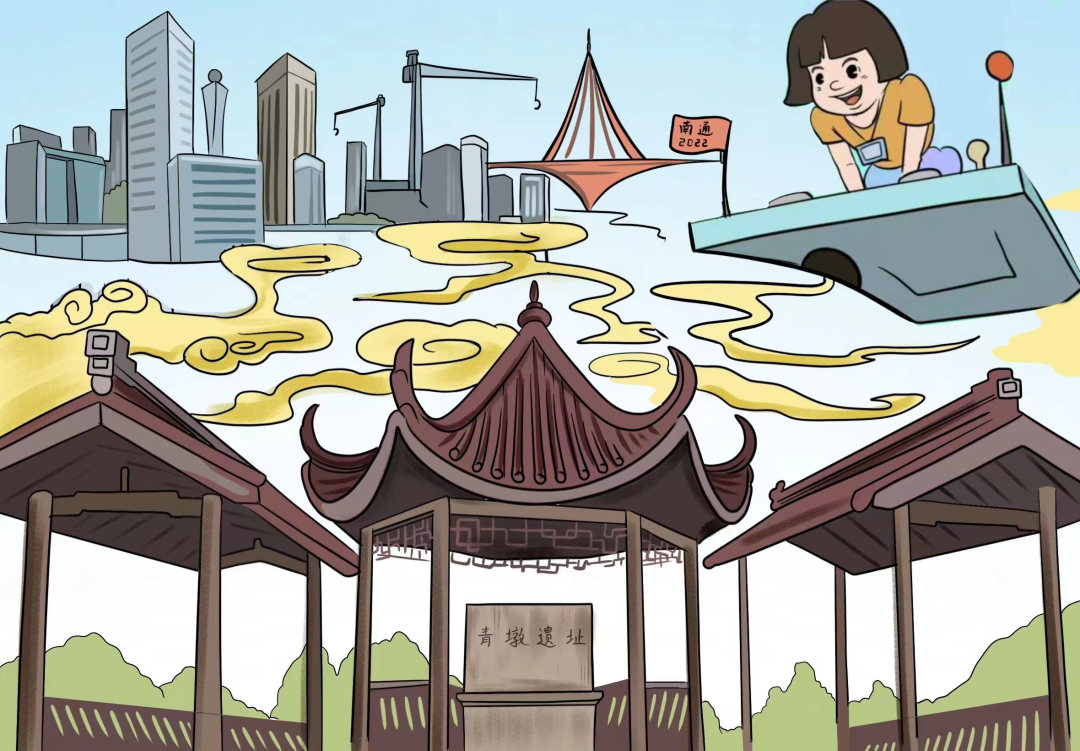漫话南通 | 第一期作品:青墩文明
漫话南通
The Story of Nantong
第一期作品 Comic illustrations (Volume I)

南通位于长江入海口北翼、江苏省东南部,素有“江海门户”之称。
Nantong stands at the north side of the mouth of the Yangtze River in southeast Jiangsu Province in China, and is known as the “gateway to the Yangtze River and the Yellow Sea.”
南通是全国著名的纺织之乡、建筑之乡、教育之乡、体育之乡、长寿之乡、文博之乡、平安之乡、新侨之乡。
The city is nationally famous for its textiles, architectures, education, and sports.It is famed for its residents’ longevity, the number of museums it has, and its high level of safety.
Moreover, it is the hometown of the largest number of new overseas Chinese immigrants across the world.
这里,滨江临海、承南启北,沐浴着中国东部第一缕阳光;
这里,历史厚重、钟灵毓秀,彰显着中国近代第一城魅力;
这里,崇商重工、经济活跃,续写着民族工业发祥地辉煌。
The river- and sea-facing Nantong connects North and South China as one of the first places in East China to see the rising sun’s first rays.
The city that boasts a long history and beautiful landscapes has its unique charm in the role of the leading city of modern China.
It attaches significant importance to business and industrial development, and its booming economy testifies to its continued glory as one of the birthplaces of China’s modern industry.
2020年11月,习近平总书记视察江苏时来到南通,点赞南通“好通”、沧桑巨变、生活幸福。
In November 2020, General Secretary Xi Jinping came to Nantong during his visit to Jiangsu.
He praised Nantong for its “strategic geographical location” and expressed his appreciation for the tremendous changes that the city has gone through to allow its people to live happily.
让我们在一幅幅漫画之中了解南通、走进南通,希冀更多海内外朋友在此中感受江海南通的独特魅力。
Let's take a closer look at Nantong through comic illustrations in this book. Hopefully, they will offer an opportunity for people within and outside China to get to appreciate the city’s extraordinary beauty.

青墩文明
Qingdun Ruins


南通历史悠久,可追溯到远古时代。 海安、如皋一带是南通成陆最早的土地。在海安西北部,有一处闻名全国考古界的古遗址,那就是20世纪70年代发现的南莫镇青墩村新石器时代遗址,亦称青墩遗址。
The history of Nantong dates back to the Neolithic Age.
Hai’an and Rugao areas are among the earliest in Nantong where land was formed.
Located in the northwestern Hai'an is an archaeological site well-known in the Chinese archaeological community: the Nanmo Town Qingdun Village Neolithic Age Archaeological Site discovered in the 1970s, also known as the Qingdun Ruins.
拥有两万多平方米的青墩遗址,为江淮东部面积最大、文化层堆积最厚且保存最完好的新石器时代遗址。
The Qingdun Ruins, covering an area of more than 20,000 square meters, is the largest, most well-preserved Neolithic archaeological site with the thickest culture layers in eastern Jianghuai Region.
对青墩遗址中层出土木炭用碳14测定,得知遗址距今5015±85年(树轮校正值6525±110年)。
Using Carbon-14 to test the charcoal excavated from the middle layer of the Qingdun Ruins, archaeologists determined that the site is 5015 (± 85) years old (and the corrected value based on dendrochronology is 6525 ± 110 years).
青墩遗址的发掘,说明至少在距今5000多年前海安就已成陆,并成为人类聚居活动之地,南通地区的人类文明史当从青墩起。
The excavation of the Qingdun Ruins testified that the land in Hai’an took shape at least 5,000 years ago, and that the area has become a human habitat since then.
It also evidences that the origin of Nantong’s history traces back to Qingdun.
青墩遗址的发现,把南通地区的历史向前推进了3000年。2006年5月,青墩遗址被国务院定为第六批全国重点文物保护单位。
The discovery of the Qingdun Ruins pushed the date of the origin of the Nantong area back to a time that was 3,000 years earlier than before.
The Qingdun Ruins was among the sixth batch of sites that were listed by the State Council on Major Historical and Cultural Sites Protected at the National Level.

考古专家列数青墩文化建树的若干第一:
Archaeologists consider the following cultural relics first of its kind:
一是 有柄穿孔陶斧,为全国墓葬发掘中仅见。它的出土解开了困扰学术界多年的“石斧如何装柄”难题,被称作“中华第一斧”。
1)A pottery axe with a pierced handle, the only axe of its kind from burial excavations throughout China.
It is considered “the first axe of China” because it helped the archaeological community solve the mystery “how to fit handles for stone axes”.
二是 陶豆圆形柄装饰纹,系我国首次发现的原始先民五等分圆实例,代表当时“数学或几何学研究的最高水平”。
2)The decorative patterns on the round handle of a pottery stemmed cup, the first example of dividing a circle into five equal parts in early times in China.
It is exemplary of the “level of advancement of the mathematics and geometry” at the time.
三是 刻纹麋鹿角的发现,被认定是易卦起源的初始符号,称为“东方第一卦”。
3)Carved elk antlers, also known as “the first hexagrams of the East” and considered the preliminary symbols of I Ching hexagrams.
四是 鹿角回旋镖作狩猎工具在亚洲太平洋地区为最早创造和使用,为我国首次发现。
4)Antler boomerangs, which were first created and used as hunting tools in the Asia-Pacific region but were discovered in China for the first time.
五是 长江北岸五六千年前的干栏式建筑为我国首次发现。
5)Pile-dwelling architecture, located on the north bank of the Yangtze River and dating back more than 5,000 years.
It was discovered in China for the first time.
六是 炭化稻谷的发现,表明青墩古人早在5000年前就开始种植水稻,与浙江良渚、河姆渡遗址比肩,更难得的是在遗址出土文物中发现了酒器。
6) Charred rice, indicating that the Qingdun people started growing rice as early as 5,000 years ago which was contemporary with the Liangzhu and Hemudu cultures in Zhejiang.
A even more precious discovery is drinking vessels unearthed from the Qingdun Ruins.

根据青墩遗址的考古发掘资料,专家们推断,当时正处于新石器时代晚期父系氏族阶段。 古青墩人开创的农耕文明是江淮文明的源头。
Based on the archaeological findings of the Qingdun Ruins, archaeologists concluded that the Ruins dates back to the late Neolithic Age when societies were organized around patrilineal kinship.
The agricultural society established by the Qingdun people is the source of the Jianghuai culture.
据考证,以青墩为中心的海安西部一带,在远古时期气候湿润,土壤肥沃,古青墩人的生产活动以刀耕火种的原始农业和渔猎为主。 以陶器制作、纺织、原始建筑为主的原始手工业已经出现,商品交换也已开始。
Archaeological discoveries revealed that the climate was humid and the soil was fertile in western Hai'an with Qingdun as the center back then.
The Qingdun people’s production activities were mainly slash-and-burn agriculture, fishing, and hunting.
At the time, the primitive handicraft industry, which centered around pottery, textiles, and preliminary architecture, had emerged, and exchange of goods had begun.
出土遗物中还发现刻有印痕的麋鹿角、骨或骨簪,专家认定这些刻纹为原始文字符号,可能用来占卜。
Also discovered in the excavation were elk antlers, bones, and bone hairpins, which archaeologists identified as preliminary textual symbols that may be used for divination.
距今约4000年前,全球气候突变,海平面上升,淹没里下河沉积平原,青墩文明进入了历史的长河。 然而,从青墩发源的江海文明之火,随着海陆变迁,薪火相传生生不息。
About 4,000 years ago, the abruptly changed global climate led to rising sea levels. As a result, the Lixiahe sedimentary plain sank, and the Qingdun culture disappeared into history.
However, the torch of civilization in Nantong, which originated from Qingdun, never ceases shining with time.

漫话系列国际传播
策划制作:中共南通市委网信办
联合传播:南通市人民政府外事办公室
主编:俞雷
撰稿:王昀
漫画:顾垚
翻译:王海霏 上海外院翻译社
一周热门
- {{index+1}}{{item.title}}



 互动
互动
 投诉建议
投诉建议 长江头条
长江头条 在线问答
在线问答 数字报
数字报
 移动端
移动端
 长江网移动端
长江网移动端 长江头条移动端
长江头条移动端